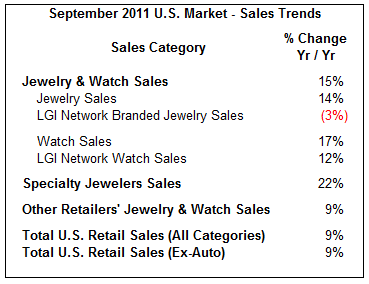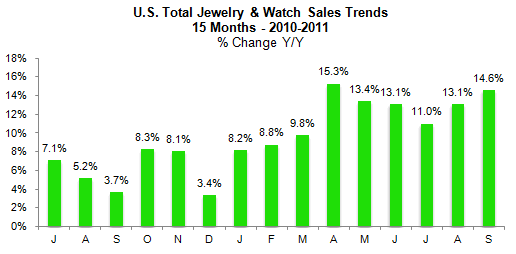IDEX Online Research: Jewelry Demand Remains Robust In U.S. Market
November 23, 11
(IDEX Online News) – Jewelry shoppers are ignoring the uncertain economy, weak housing market and high unemployment in the
Full details about the September sales are available to IDEX Online Research subscribers and IDEX Online members here.
While much of the jewelry industry sales increase – up nearly 15 percent for the month of September as measured by “dollars through the cash register” – is the result of price inflation related to polished diamond and precious metals prices, unit sales are up by an estimated 3 percent.
These sales trends tell us several things:
· Jewelry demand seems to be price inelastic, at least at the current price levels. Message to jewelers: “Don’t get between a jewelry shopper and her desire for jewelry: she wants fine jewelry, and she’s willing to pay for it.”
· Since unit sales are up, fundamental underlying demand for jewelry is clearly strengthening.
· Most jewelers are reporting more transactions, though the average transaction value is often slightly lower than in pre-recession days. This confirms that more jewelry shoppers are in stores buying jewelry.
Here’s the preliminary jewelry sales report for September 2011:
· Total
·
While these numbers seem overly optimistic, we noted the same thing about August numbers. The government has provided revised data for August and prior months, but the percentage gains did not change dramatically. The IDEX Online Research sample of jewelers shows composite gains in the high teen range, rather than the nearly 22 percent gain reported by the government. Either way, though, jewelry sales are strong.
Here are some high-level trends that we believe reliably reflect jewelry sales during the month of September 2011:
· Specialty jewelers took market share from other merchants – discounters, mass marketers and online sellers – who sell jewelry.
· Watch sales moderately outpaced jewelry sales. The LGI Network data reflects this same trend, and its numbers are close to the government sales numbers for watches.
· Year-to-date jewelry industry sales are up by about 12 percent, as measured by dollar volume (“dollars through the cash register”). This is comprised of a unit sales gain of about 3 percent, along with a 9 percent increase in jewelry prices due to price inflation related to higher diamond and precious metals prices. That’s why so many jewelers say that, despite solid dollar sales, it doesn’t “feel” like jewelry sales are up strongly. We note that specialty jewelers’ year-to-date sales are up by about 13.5 percent, which means that their unit sales are up by more than 4 percent.
· The jewelry industry – especially specialty jewelers – took significant market share (“share of wallet”) from other retail categories.
· Sales of branded jewelry, as compiled by the LGI Network, an NPD Group company, showed a notable decline of about 3 percent in September. This indicates that consumers continue to seek a fashion look at a value price; brands are less important than “the look.”
The table below summarizes jewelry and watch sales data in the
 Source: US Dept. of Commerce |
Demand for luxury goods – especially higher-end merchandise – has been solid for the past few months, and jewelry is benefitting from this trend. The graph below shows total jewelry and watch sales trends for the past fifteen months.
 Source: US Dept. of Commerce |
Outlook for Jewelry Demand Remains Positive
By all counts, American shoppers should be spooked: the politicians in
In fact, the consumer sentiment indices are at low levels.
However, we know this: there is little correlation between consumer sentiment and retail sales. Most credible economists ignore consumer sentiment indices when making their sales forecasts.
Why are American shoppers still in the stores buying jewelry? The reasons seem qualitative:
· There is significant pent-up demand for jewelry.
· Consumers are tired of hearing recession rhetoric from the mass media talking heads.
· Two old adages come to mind:
o “Americans are born to shop”
o “When the going gets tough, the tough go shopping.”
Earlier in the quarter, two major public companies reported interim sales results through the end of September; these sales trends confirm that the strong sales gains are continuing.
Based on nine months of 2011 sales data, the U.S. jewelry and watch sales could grow to as much as $70 billion for the full year ending December 2011, a gain of about 13-14 percent over 2010 sales levels, based on newly revised data from the Department of Commerce.
We continue to remain skeptical of the Commerce Department’s numbers: a gain in the mid-to-high single digit range seems much more reasonable to us. This would yield jewelry sales in the $65-66 billion range for the year. Further, over the next couple of years, we believe that jewelry sales gains will settle in at about 4 percent or so annually, assuming that inflation moderates to historic levels.
For additional detailed information about September sales, please click HERE.
Full details about the September sales are available to IDEX Online Research subscribers and IDEX Online members here. Click here for more information on how to subscribe or become a member.